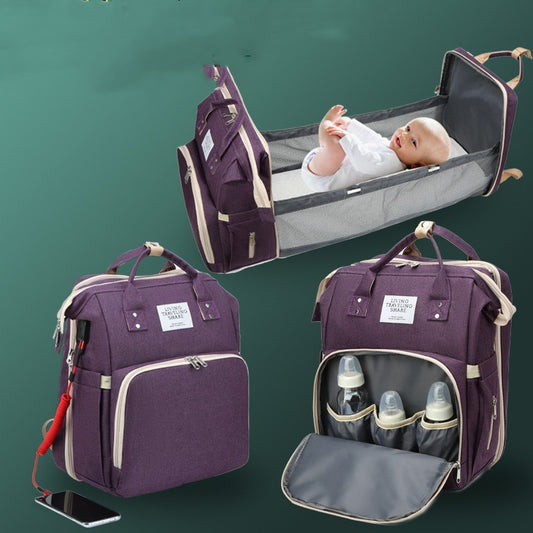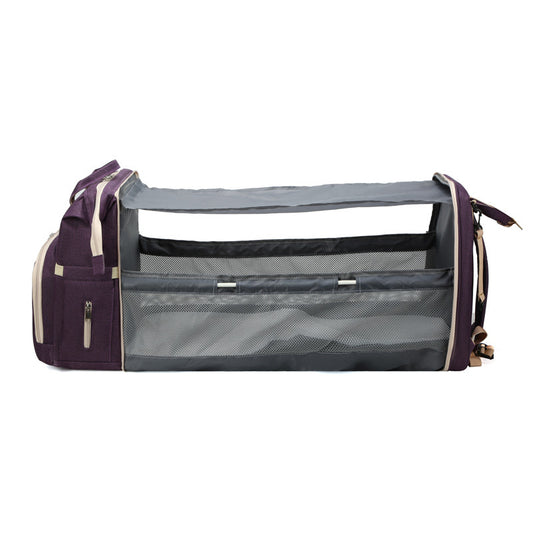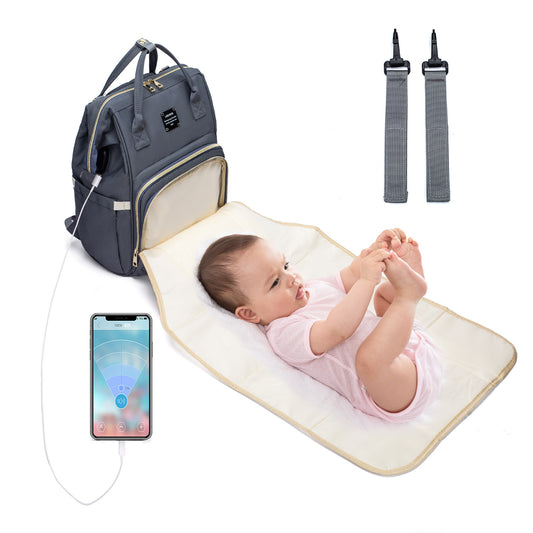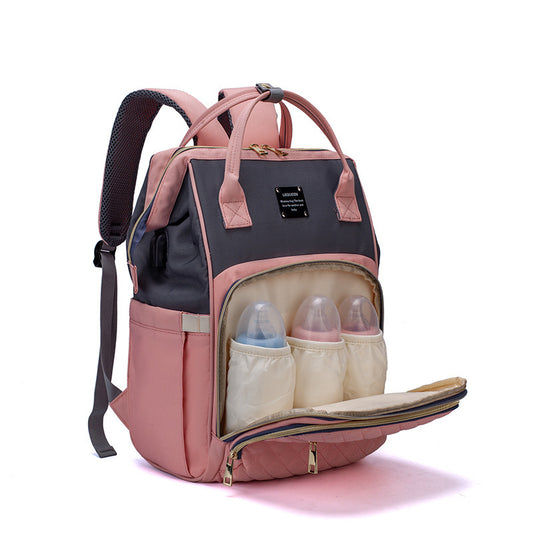Your baby changing bag is one of the hardest-working items in your parenting toolkit. From daily nappy changes to park visits, appointments, nursery drop-offs and family trips — it sees it all. But how long can you expect it to last?
It’s a question many UK parents ask before buying:
How long do baby changing bags actually last — and what affects their lifespan?
The truth is, durability depends on several factors: build quality, material, frequency of use, how you care for it — and how well it’s designed to handle changes in your child’s routine.
In this guide, we look at:
-
The average lifespan of a baby changing bag
-
What shortens or extends a bag’s usability
-
Ideal features and materials for long-term use
-
Tips for maximizing your bag’s lifespan
-
Signs it’s time to replace your nappy bag
How Long Should a Baby Changing Bag Last?
On average, a high-quality baby changing bag will last between:
18 months to 3 years — with moderate to daily use.
However, with proper care and smart choice of materials, many durable designs can last:
-
Up to 4–5 years for ongoing daily use
-
Beyond the newborn years — used later as a travel, gym or work bag
Premium brands or multifunctional baby bags — such as those sold on Kidyra.Store — often fall into this longer-lasting category when maintained properly.
What Impacts the Lifespan of a Baby Changing Bag?
1. Material Quality
Durability starts with what the bag is made of. For example:
-
Oxford Water-Resistant Polyester/Nylon – lasts 3–5 years, extremely durable, low maintenance
-
Canvas – 1.5–3 years with proper care, though may fade or stain
-
Vegan or Faux Leather – 1–2 years on average without cracking, depending on quality
-
Genuine Leather – 2–4 years with proper conditioning
Bags made with thin, untreated PU, cheap plastics, or poorly woven fabric tend to show signs of wear within 6–12 months.
2. Construction & Stitching
Signs of strong construction include:
-
Double-stitched handles
-
Reinforced base layer
-
Boxed side seams
-
Sturdy zip tracks and pullers
-
Metal or heavy plastic hardware (not low-grade clips)
Bags with poor construction often fail at the stress points — such as zip seams, bottom corners, or bottle compartments after frequent stretching.
3. Frequency of Use
A full-time parent or carer using the bag daily (including for travel, nursery, clinic visits) will likely need to replace or upgrade the bag sooner than someone using it 2–3 times weekly.
Daily use with full loads contributes to:
-
Strap fatigue
-
Interior lining breakdown
-
Zip damage
-
External scuffing or moisture wear
4. Care and Maintenance
Regular, proper cleaning actually extends bag life. Neglect, on the other hand, shortens it fast.
Common causes of premature failure include:
-
Leaving wet items inside (leads to mildew)
-
Excess food or formula spills that aren’t wiped quickly
-
Unwashed interiors where bacteria build up over time
-
Rough handling or overloading weight frequently
See our guide [How to Clean Your Baby Changing Bag] for tips.
5. Storage Method
Bags stuffed too tightly, left in humid spaces, or stored under weight may:
-
Lose structure
-
Develop musty smells
-
Crack or warp fabrics
-
Damage internal reinforcements
Store upright, lightly filled, and away from moisture to keep the bag in shape.
Which Baby Bags Last the Longest?
Here’s a performance snapshot of different types:
|
Type |
Expected Lifespan |
Notes |
|
Lightweight tote (non-structured) |
6–12 months |
Good for light use only |
|
Canvas backpack with basic lining |
1.5–2 years |
Needs frequent cleaning; avoid overloading |
|
Oxford backpack bag (e.g. Kidyra.Store models) |
3–5 years |
Durable, weather-resistant, multi-functionality |
|
Designer leather tote bag |
2–4 years (with care) |
Stylish, can double as work bag; not ideal for heavy loads |
|
Hybrid travel bag with changing mat |
3–4 years |
Good for future re-use as general travel backpack |
Multifunctional, structured, waterproof backpacks with reinforced wear zones clearly last the longest — especially with daily use.
Signs It’s Time to Replace Your Baby Changing Bag
Even premium bags don’t last forever. Watch for:
-
Tears in the bottom corner or strap seams
-
Broken or jamming zippers
-
Fabric separation in compartments
-
Loss of waterproof lining effectiveness (absorption, smell)
-
Sticky inner lining from milk/formula buildup
-
Unstable structure no longer holding shape
-
Persistent odour even after cleaning
-
It no longer suits your child’s stage (e.g. toddler gear vs newborn essentials)
How to Extend the Life of Any Baby Bag
Give your bag the best chance of lasting as long as possible with these practices:
1. Clean Internally and Externally Monthly
Use a soft sponge, baby-safe cleaning solution, and allow to air dry fully. Remove bottle inserts during deep cleans.
2. Keep a Water-Resistant Storage Pouch
Use this for dirty clothes or nappies inside the bag instead of letting items sit in direct contact with the main lining. This limits mould buildup.
3. Distribute Weight Evenly
Shift heavier items (bottles, wipes packs) toward the centre bottom and avoid leaning too much weight on one strap.
4. Rotate Your Bag (If You Own More Than One)
Have a smaller grab-and-go bag or weekend bag to reduce the load on your primary daily-use nappy bag.
5. Air the Bag Weekly
Leave it open overnight in a ventilated space — especially after long travel days or during warmer months.
Can You Use a Baby Changing Bag Beyond the Baby Stage?
Yes — and this is exactly where better-made bags show their value.
After your baby grows out of nappies, you can convert your bag into:
-
Travel daypack or carry-on
-
Work tote for laptops and organisation
-
Bag for toddler meals, books or nursery gear
-
Picnic bag with cooler section reuse
-
Gym bag for parents with active routines
Premium models like those on Kidyra.Store include:
-
Built-in insulated bottle zones (usable for food, water, or thermal items during day trips)
-
Document sleeves for laptops or papers
-
USB charging ports for working parents
-
Layers of internal space that suit multiple life stages
Kidyra Baby Bags: Designed for Longevity
From the product listings and product images provided, we assess that Kidyra baby bags are built with above-average durability due to:
-
Reinforced Oxford waterproof material
-
Strong double-strapped design
-
USB charging port options
-
Wide main opening and structured base
-
Separate wet and dry compartments
-
Fold-out cots and mats for older babies
-
Multi-use design for adaptable life stages
These bags blend practicality, style, and wear resistance, proving effective even three years on.
Conclusion
A good baby changing bag lasts through more than just nappies — it often sees your child through crawling, walking, nursery, and even those early school years.
Selecting the right material, avoiding overloading, maintaining regular care, and choosing a multi-functional design are key to ensuring your bag truly lasts.
For long-term value and everyday practicality, choose a bag built to grow with your journey — not disappoint halfway through it.
Ready for a changing bag built to last?
Explore Kidyra.Store’s range of durable, multi-use baby changing bags, designed for long-term parenting and beyond.
FAQs
Q1. How long will a baby bag typically last with daily UK usage?
Around 2–3 years with moderate wear. With good care and premium materials, 4–5 years is realistic — especially with Oxford fabric models.
Q2. Is it worth investing in a more expensive bag for longevity?
Yes, if you use it daily. A durable £50–£70 bag that lasts 4 years is better value than replacing a £25 one every 10 months.
Q3. Can I repair a baby changing bag?
Often yes. Zips, stitching, and minor inner tore linings can be repaired. Consider a local bag service before replacing.
Q4. What makes Kidyra bags last longer?
Waterproof outer, strong hardware, multi-use design, and structural shape retention all contribute to longer life.
Q5. Can I re-purpose my baby bag?
Absolutely. Once the nappy phase is over, reuse it for travel, work, or outings with toddlers.





